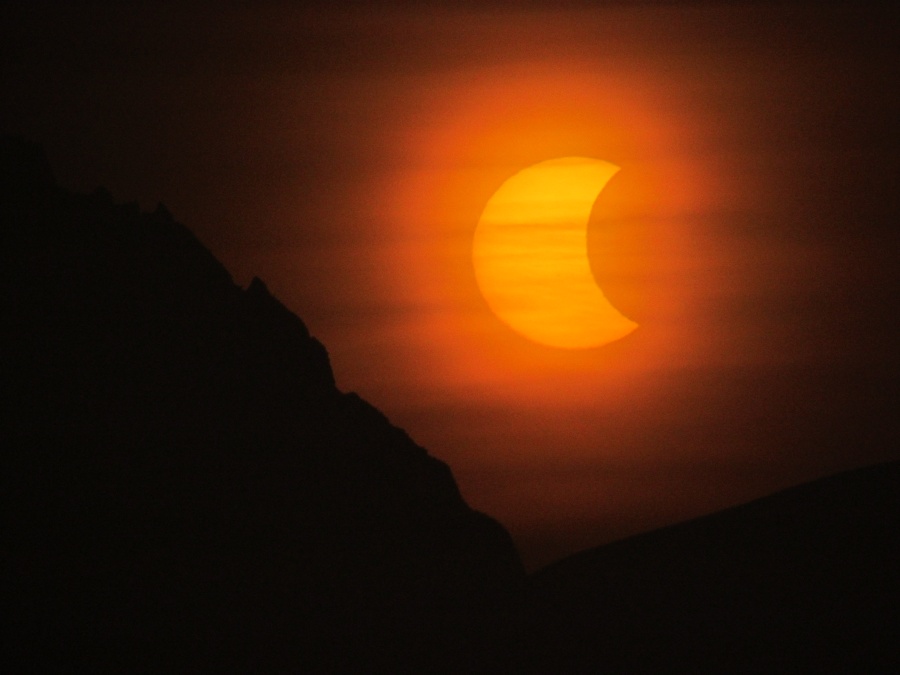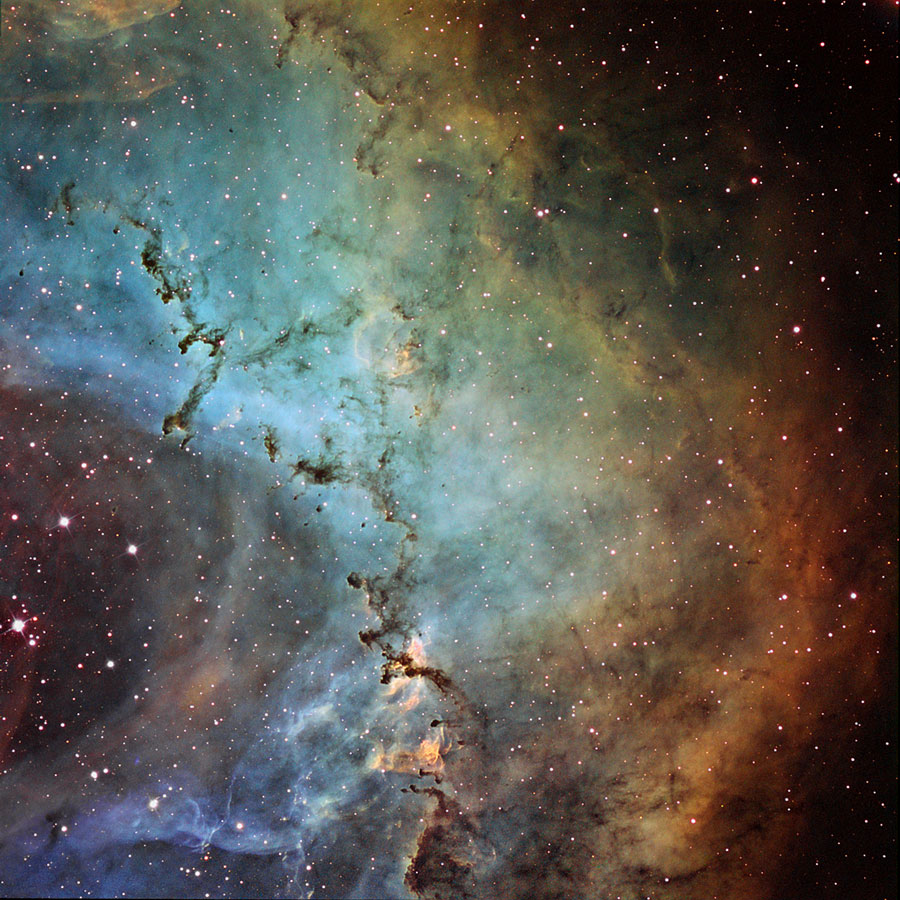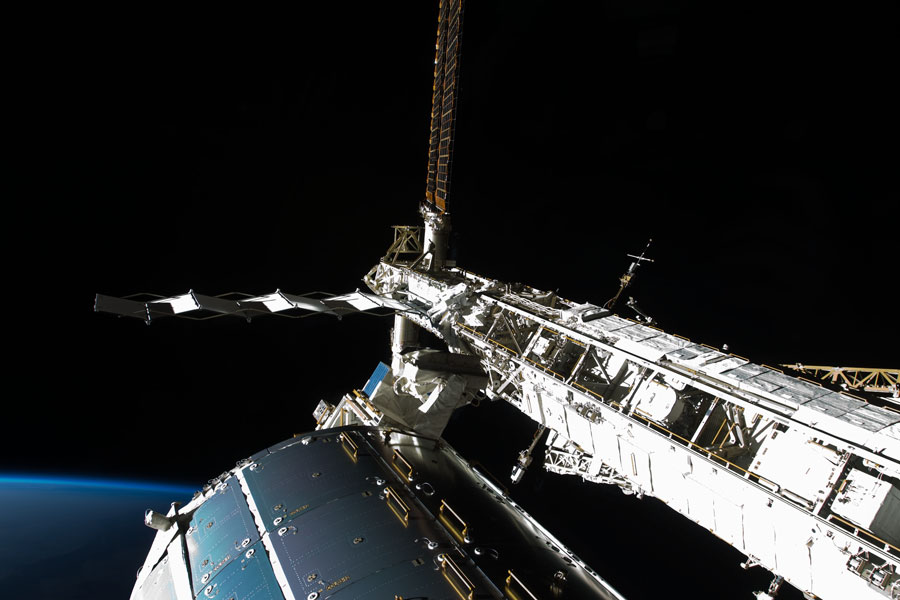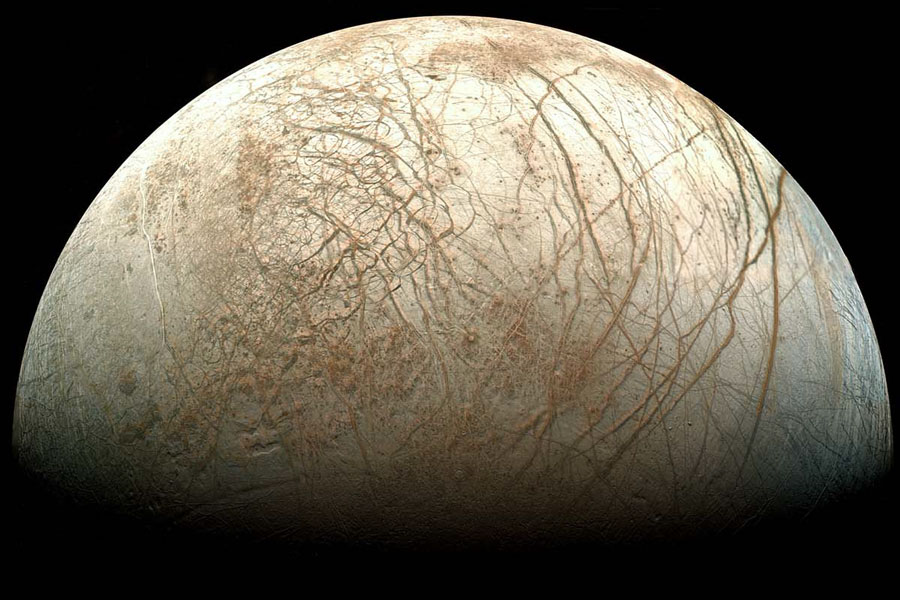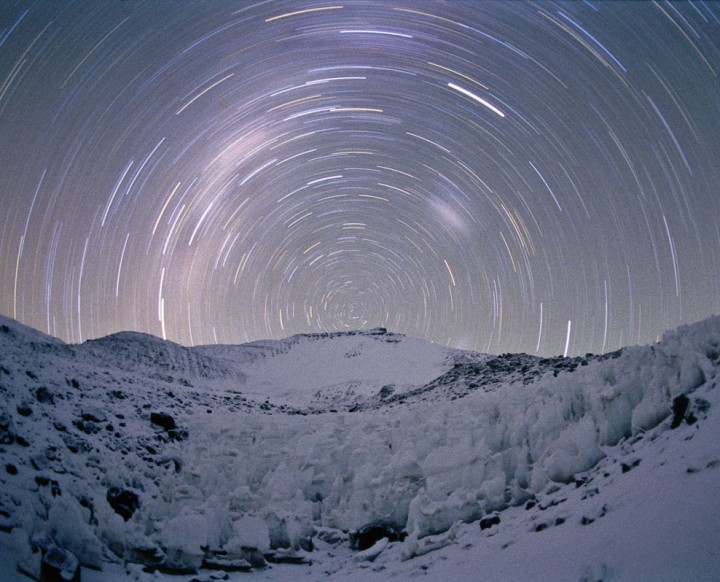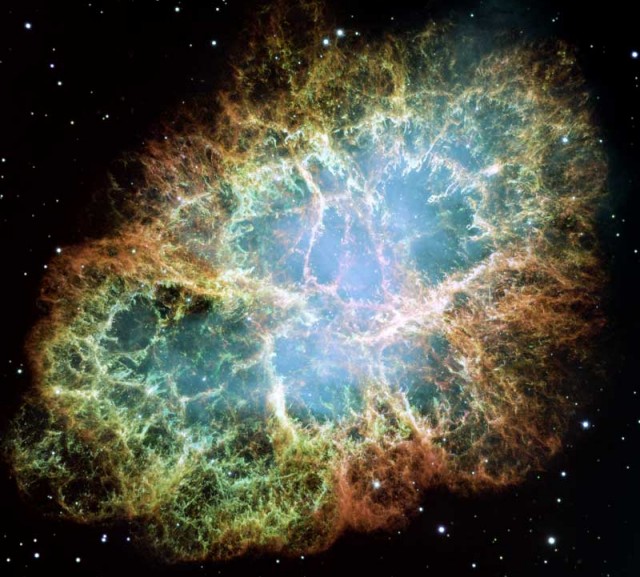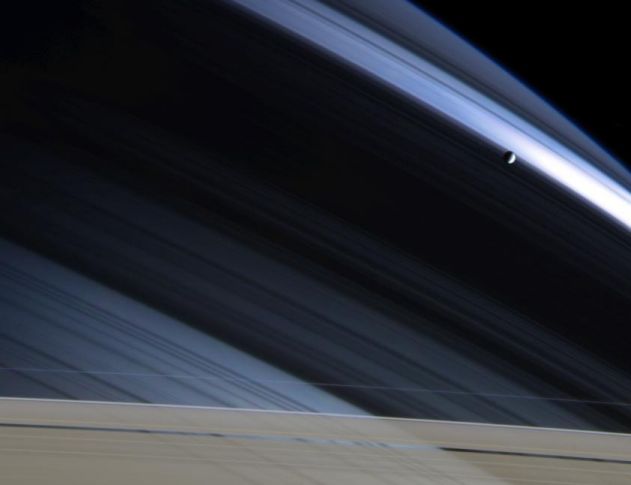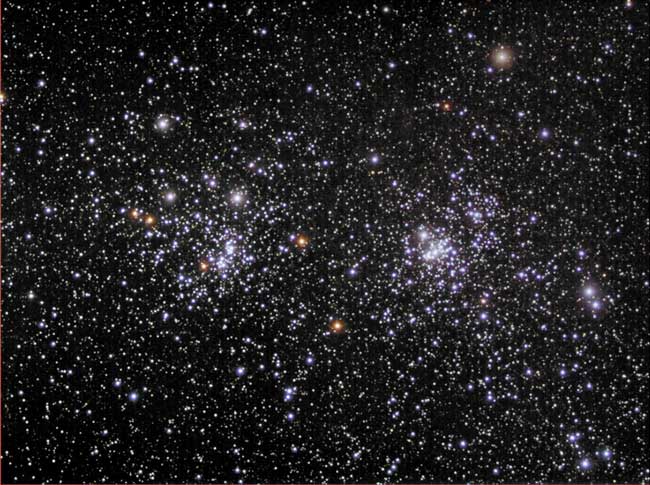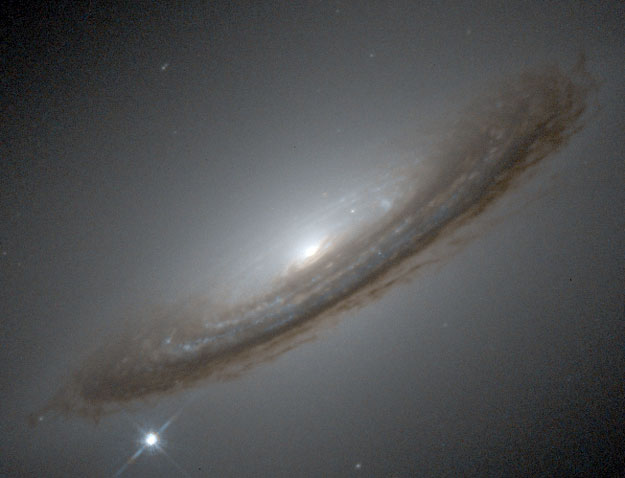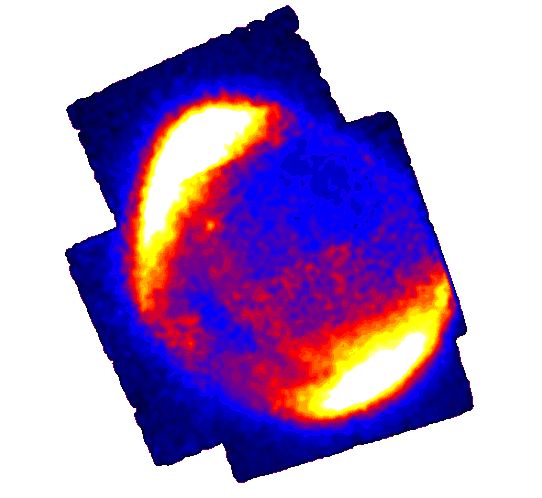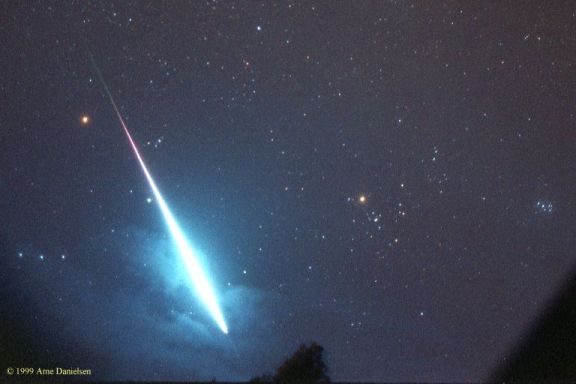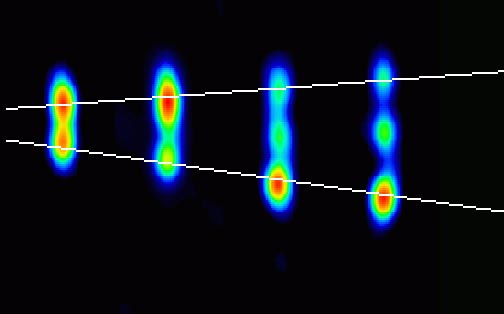| << Previous | Index | Next >> |
2014 How did the Eta Carinae star system create this unusual expanding nebula? No one knows for sure. About 170 years ago, the southern star system Eta Carinae (Eta Car) mysteriously became the second brightest star system in the night sky. Twenty years later, after ejecting more mass than our Sun, Eta Car unexpectedly faded. Somehow, this outburst appears to have created the Homunculus Nebula. The three-frame video features images of the nebula taken by the Hubble Space Telescope in 1995, 2001, and 2008. The Homonculus nebula's center is lit by light from a bright central star, while the surrounding regions are expanding lobes of gas laced with filaments of dark dust. Jets bisect the lobes emanating from the central stars. Expanding debris includes streaming whiskers and bow shocks caused by collisions with previously existing material. Eta Car still undergoes unexpected outbursts, and its high mass and volatility make it a candidate to explode in a spectacular supernova sometime in the next few million years.
2013 Comet Lovejoy was captured last week passing well in front of spiral galaxy M63. Discovered only three months ago and currently near its maximum brightness, Comet Lovejoy can be seen near the Big Dipper from dark northerly locations before dawn with the unaided eye. An unexpected rival to Comet ISON, C/2013 R1 (Lovejoy), pictured above, is currently sporting a large green coma and a beautifully textured ion tail. Comet Lovejoy is now headed back to the outer Solar System but should remain a good sight in binoculars for another few weeks. Conversely, spiral galaxy M63, lies far in the distance and is expected to remain stationary on the sky and hold its relative brightness for at least the next few million years.
2012 Is the night sky darkest in the direction opposite the Sun? No. In fact, a rarely discernable faint glow known as the gegenschein (German for "counter glow") can be seen 180 degrees around from the Sun in an extremely dark sky. The gegenschein is sunlight back-scattered off small interplanetary dust particles. These dust particles are millimeter sized splinters from asteroids and orbit in the ecliptic plane of the planets. Pictured above from 2008 October is one of the more spectacular pictures of the gegenschein yet taken. Here a deep exposure of an extremely dark sky over Paranal Observatory in Chile shows the gegenschein so clearly that even a surrounding glow is visible. In the foreground are several of the European Southern Observatory's Very Large Telescopes, while notable background objects include the Andromeda galaxy toward the lower left and the Pleiades star cluster just above the horizon. The gegenschein is distinguished from zodiacal light near the Sun by the high angle of reflection. During the day, a phenomenon similar to the gegenschein called the glory can be seen in reflecting air or clouds opposite the Sun from an airplane.
2011 Last Friday, the fourth and final partial solar eclipse of 2011 was only visible from high latitudes in the southern hemisphere. If you missed it, check out this dramatic picture of the geocentric celestial event from a very high southern latitude on the continent of Antarctica. From a camera positioned at San Martín Station (Argentina) near the antarctic peninsula mountain range, the picture looks toward the south and east. The Sun and silhouetted lunar disk are seen through thin, low clouds. Perhaps fittingly, the mountainous slope in the foreground is part of the larger Roman Four Promontory, named for its craggy, snow covered face that resembles the Roman numeral IV. For 2011, there is actually one more eclipse to go, a total eclipse of the Moon. Parts of that eclipse will be visible from most of planet Earth (but not Antarctica ...) on December 10.
2010 Early in November, small but active Comet Hartley 2 (103/P Hartley) became the fifth comet imaged close-up by a spacecraft from planet Earth. Continuing its own tour of the solar system with a 6 year orbital period, Hartley 2 is now appearing in the nautical constellation Puppis. Still a target for binoculars or small telescopes from dark sky locations, the comet is captured in this composite image from November 27, sharing the rich 2.5 degree wide field of view with some star clusters well known to earthbound skygazers. Below and right of the comet's alluring green coma lies bright M47, a young open star cluster some 80 milion years old, about 1,600 light-years away. Below and left open cluster M46 is older, around 300 million years of age, and 5,400 light-years distant. Hartley 2's short, faint tail even extends up and right toward another fainter star cluster in the scene, NGC 2423. On November 27, Comet Hartley 2 was about 2.25 light-minutes from Earth. Sweeping toward the bottom of this field, by November 28 the comet's path had carried it between M46 and M47.
2009 What creates the cosmic dust sculptures in the Rosette Nebula? Noted for the common beauty of its overall shape, parts of the Rosette Nebula, also known as NGC 2237, show beauty even when viewed up close. Visible above are globules of dark dust and gas that are slowly being eroded away by the energetic light and winds by nearby massive stars. Left alone long enough, the molecular-cloud globules would likely form stars and planets. The above image was taken in very specific colors of Sulfur (shaded red), Hydrogen (green), and Oxygen (blue). The Rosette Nebula spans about 50 light-years across, lies about 4,500 light-years away, and can be seen with a small telescope towards the constellation of the Unicorn (Monoceros).
2008 Where's the astronaut? Somewhere in this impressive array of International Space Station (ISS) hardware, astronaut Steve Bowen can be found upgrading and cleaning key parts of Earth's most prominent orbital outpost. Astronaut Bowen and Heidemarie Stefanyshyn-Piper (not pictured), part of the Space Shuttle Endeavour's recently ended STS-126 mission to the ISS, spent nearly three hours on this spacewalk hovering high above planet Earth. Bowen progressed toward achieving a key goal of the mission -- servicing of the Solar Alpha Rotary Joints to better allow some solar arrays to track the Sun. In the lower foreground of the above image is the cylindrical Columbus Laboratory, protruding from the right is an impressively large space station truss, while in the background are some of the expansive solar arrays that collect sunlight to power the ISS. Far in the distance, a blue arc of Earth's thin atmosphere is visible on the horizon. The next space shuttle flight is scheduled for 2009 February, when Discovery will deliver elements to further expand the ISS.
2007 Although the phase of this moon might appear familiar, the moon itself might not. In fact, this gibbous phase shows part of Jupiter's moon Europa. The robot spacecraft Galileo captured this image mosaic during its mission orbiting Jupiter from 1995 - 2003. Visible are plains of bright ice, cracks that run to the horizon, and dark patches that likely contain both ice and dirt. Raised terrain is particularly apparent near the terminator, where it casts shadows. Europa is nearly the same size as Earth's Moon, but much smoother, showing few highlands or large impact craters. Evidence and images from the Galileo spacecraft, indicated that liquid oceans might exist below the icy surface. To test speculation that these seas hold life, ESA has started preliminary development of the Jovian Europa Orbiter, a spacecraft proposed to orbit Europa. If the surface ice is thin enough, a future mission might drop hydrobots to burrow into the oceans and search for life.
2006 In myth, Atlas holds up the heavens, but in this stunning view a mountain appears to serve as the southern night sky pivots around a snowy peak. Recorded during a climbing expedition at an altitude above 19,000 feet (temperature -18 degrees C), the picture places the South Celestial Pole over the Andes mountain Ojos del Salado. Topping out at over 22,000 feet, the Ojos del Salado is a stratovolcano, the highest active volcano on planet Earth. The time exposure lasted for an hour, recording the graceful arcing star trails along with the rising Milky Way (left) and setting Magellanic clouds.
2005 The Crab Nebula is cataloged as M1, the first object on Charles Messier's famous list of things which are not comets. In fact, the cosmic Crab is now known to be a supernova remnant, an expanding cloud of debris from the death explosion of a massive star. Light from that stellar catastrophe was first witnessed by astronomers on planet Earth in the year 1054. Composed of 24 exposures taken in October 1999, January 2000, and December 2000, this Hubble Space Telescope mosaic spans about twelve light years. Colors in the intricate filaments trace the light emitted from atoms of hydrogen, oxygen, and sulfur in the debris cloud. The spooky blue interior glow is emitted by high-energy electrons accelerated by the Crab's central pulsar. One of the most exotic objects known to modern astronomers, the pulsar is a neutron star, the spinning remnant of the collapsed stellar core. The Crab Nebula lies about 6,500 light-years away in the constellation Taurus.
2004 Caught in sunlight, icy moon Mimas shines above a broad shadow across gas giant Saturn. In this remarkable image from the Cassini spacecraft, tiny Mimas is at the upper right. The broad shadow across the giant planet is cast by Saturn's dense B ring with intriguing threadlike shadows from Saturn's inner C ring arrayed below. While the B and C rings are otherwise not visible here, the very narrow outer F ring lies toward the bottom of the image as well as a section of the partly transparent A ring and its 300 kilometer wide Encke gap crisscrossing the ring shadows. Sunlight streaming through the much larger Cassini gap that separates the A and B rings is responsible for the bright band seen above Mimas. The Cassini gap itself is just off the bottom of this cropped view. Orbiting well beyond Saturn's F ring, Mimas is a mere 400 kilometers in diameter.
2003 Most star clusters are singularly impressive. Open clusters NGC 869 and NGC 884, however, are doubly impressive. Also known as "h and chi Persei", this unusual double cluster, shown above, is bright enough to be seen from a dark location without even binoculars. Although their discovery surely predates written history, the Greek astronomer Hipparchus notably cataloged the "double cluster". The clusters are over 7000 light years distant toward the constellation of Perseus, but are separated by only hundreds of light years.
2002 Spiral galaxy M33 is a mid-sized member of our Local Group of Galaxies. M33 is also called the Triangulum Galaxy for the constellation in which it resides. About four times smaller (in radius) than our Milky Way Galaxy and the Andromeda Galaxy (M31), it is much larger than the many of the local dwarf spheroidal galaxies. M33's proximity to M31 causes it to be thought by some to be a satellite galaxy of this more massive galaxy. M33's proximity to our Milky Way Galaxy causes it to appear more than twice the angular size of the Full Moon, and be visible with a good pair of binoculars. The above high-resolution image from the 0.90-m telescope at Kitt Peak National Observatory is a four-color composite.
2001 Three years ago results were first presented indicating that most of the energy in our universe is not in stars or galaxies but is tied to space itself. In the language of cosmologists, a large cosmological constant is directly implied by new distant supernovae observations. Suggestions of a cosmological constant (lambda) are not new -- they have existed since the advent of modern relativistic cosmology. Such claims are not usually popular with astronomers, though, because lambda is so unlike known universe components, because lambda's value appears limited by other observations, and because less-strange cosmologies without lambda have previously done well in explaining the data. What is noteworthy here is the seemingly direct and reliable method of the observations and the good reputations of the scientists conducting the investigations. Over the past three years, two independent teams of astronomers have continued to accumulate data that appears to confirm the unsettling result. The above picture of a supernova that occurred in 1994 on the outskirts of a spiral galaxy was taken by one of these collaborations. Still, extraordinary claims require extraordinary evidence, and so cosmologists the world over continue to await more data and confirmation by independent methods.
2000 Research balloon flights conducted in 1912 by Austrian physicist Victor Hess revealed that the Earth was constantly bombarded by high energy radiation from space - which came to be called "Cosmic Rays". What are Cosmic Rays and where do they come from? They are now known to be mostly subatomic particles - predominantly protons and electrons - but their origin is a long standing mystery. After almost a century of study, this cosmic puzzle may have been at least partially solved by X-ray images and spectra from the ASCA satellite observatory. Pieced together to show the region around a star observed to go supernova in 1006 AD, the overlapping X-ray snapshots above (seen in false color) reveal the bright rims of the exploded star's still expanding blast wave. These ASCA observations showed for the first time that the energy spectrum of the bright regions is like that produced by extremely high energy electrons streaming through a magnetic field at nearly the speed of light. If (as expected) high energy protons are associated with these energetic electrons then supernova remnants like SN 1006 are sources of Hess' puzzling Cosmic Rays.
1999 Most Leonid meteoroids, the bits of comet debris which produce the annual Leonid meteor shower, range from a mere millimeter to a centimeter in diameter. Yet these cosmic grains of sand and gravel can put on quite a spectacular show. How can something so small generate so much light? The answer is their astronomical speed, as these particles enter Earth's atmosphere at around 71 kilometers per second. In the high-speed collisions with air molecules, electrons are stripped from atoms as meteroid material is blasted away. When the electrons recombine with the atoms, light is emitted. This dramatic example of a brilliant 1999 Leonid meteor was photographed while tracking the stars in partly foggy skies on November 18, from a location near Dagali, Norway. The two bright reddish-orange stars visible are the familiar giant stars Betelgeuse (left) and Aldebaran.
1998 This new deep view of the cosmos is the sequel to the 1995 hit Hubble Space Telescope Deep Field. Billed as the Hubble Deep Field South, it was produced by pointing the space telescope toward a patch of sky in the southern constellation Tucana. Over a period of 10 days, many separate exposures were accumulated and combined to reveal progressively fainter galaxies. The original deep field was constructed by observing a piece of sky in the northern constellation Ursa Major. Both stare down 12 billion light-year long tunnels to far-off and still mysterious times when young galaxies inhabited an infant universe. Hubble Deep Field South observations were released to an enthusiastic audience on November 23, 1998.
1997 On the far side of our Galaxy, gas clouds explode away from a small black hole. This might seem peculiar, as black holes are supposed to attract matter. But material falling toward a black hole collides and heats up, creating an environment similar to a quasar that is far from stable. In the above time-lapse sequence, micro-quasar GRS1915 expels bubbles of hot gas in spectacular jets. These computer enhanced radio images show one plasma bubble coming almost directly toward us at 90 percent the speed of light, and another moving away. Each of the four frames marks the passage of one day. Originally detected on October 29th, these bubbles have now faded from view.
1996 What determines a star's color? Its temperature. Red stars are cool, with temperatures of around 3,000 kelvins (K), while blue stars are hotter and can have temperatures over 30,000 degrees K. Our own lovely yellow Sun's temperature is a comforting 6,000 K. Differences in star colors are dramatically illustrated in the above photo of the constellation Orion, made using a "star trail step-focus" technique. In this technique, a time exposure is used to create star trails, but during the exposure, the focus is changed in steps. For the brighter stars, the blurred image produces more saturated colors in photographs. At the upper left, the cool red supergiant Betelgeuse stands out from the other, hotter, bluish stars composing the body of the constellation. Bright Rigel, a blue supergiant, is at the lower right.
1995 In May of 1993, the Space Shuttle Columbia orbited the Earth carrying the Spacelab Deutsche 2 (SL-D2) science module and spacelab tunnel seen here riding in the shuttle's payload bay. Below, thunderstorms rage over the cloudy Earth. Several lightning flashes are visible in this high speed photograph as intense bright streaks within the clouds. The lights near the center of the picture, just above the the shuttle's tail, are believed to be Mexico City.
| << Previous | Index | Next >> |



